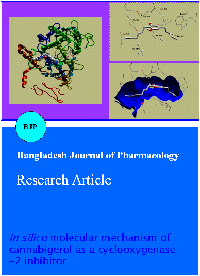In silico molecular mechanism of cannabigerol as a cyclooxygenase-2 inhibitor
DOI:
https://doi.org/10.3329/bjp.v8i4.16617Keywords:
COX-2 enzyme, Docking, InflammationAbstract
Discovery of new cyclooxygenase-2(COX-2) inhibitors is a major area in anti-inflammatory drug discovery. Cannabigerol is a cannabinoid, which is recently discovered as a new COX-2 inhibitor. So far no work has been done to explore in depth mechanistic insights to understand its mechanism and binding mode. In the current investigation, molecular docking simulations were performed to explore its binding mode and is molecular interactions with the ligand binding site of COX-2 enzyme. Cannabigerol showed multiple molecular contacts with active of COX-2 especially withArg120, Tyr355, and Met522. Hydrogen bonding, dipole-dipole and hydrophobic interactions were the key attractive forces involved in macromolecular contacts. Molecular modifications in Cannabigerol are discussed, which can lead to further improvement of the ligand as a new lead compound against COX-2 enzyme.
Downloads
487
201 Read
36
References
Chen QH, Rao PN, Knaus, EE. Design, synthesis, and biological evaluation of N-acetyl-2-carboxybenzene sulfonamides: A novel class of cyclooxygenase-2 (COX-2) inhibitors. Bioorg Med Chem. 2005; 13: 2459-68.
Crofford LJ. COX-1 and COX-2 tissue expression: Implications and predictions. J Rheumatol. 1997; 24: 15-19.
Habeeb AG, Praveen PN, Knaus, EE. Design and synthesis of celecoxib and rofecoxib analogues as selective cyclooxygen-ase-2 (COX-2) inhibitors: Replacement of sulfonamide and methylsulfonyl pharmacophores by an azidobioisostere. J Med Chem. 2001; 44: 3039-42.
McAdam BF, Catella-Lawson F, Mardini IA, Kapoor S, Lawson JA, FitzGerald GA. Systemic biosynthesis of prostacyclin by cyclooxygenase (COX)-2: The human pharmacology of a selective inhibitor of COX-2. Proc Natl Acad Sci USA. 1999; 96: 272-77.
Needleman P, Isakson P. The discovery and function of COX-2. J Rheumatology 1997; 24: 6-8.
O"Banion MK, Sadowski HB, Winn V, Young DA. A serum- and glucocorticoid-regulated 4-kilobase mRNA encodes a cyclooxygenase-related protein. J Bio Chem. 1991; 266: 23261-67.
Picot D, Loll PI, Garavito RM. The X-ray crystal structure of the membrane protein prostaglandin H2 synthase-1. Nature 1994; 367: 243-49.
Rehman UU, Shah J, Khan MA, Shah MR, Khan I. Molecular docking of taraxerol acetate as a new COX inhibitor. Bangladesh J Pharmacol. 2013; 8: 194-97.
Selvam C, Jachak, SM, Thilagavathi, R, Chakraborti AK. Design, synthesis, biological evaluation and molecular docking of curcumin analogues as antioxidant, cyclooxygenase inhibitory and anti-inflammatory agents. Bioorg Med Chem Lett. 2005; 15: 1793-97.
Vane JR. Inhibition of prostaglandin synthesis as a mechanism of action for aspirin-like drugs. Nature New Biol. 1971; 231: 232-35.
Zogopoulos P, Vasileiou I, Patsouris E, Theocharis SE. The role of endocannabinoids in pain modulation. Fund Clin Pharmacol. 2013; 27: 64-80.

Published
How to Cite
Issue
Section
License
Authors who publish with this journal agree to the following terms:
- Authors retain copyright and grant the journal right of first publication with the work simultaneously licensed under a Creative Commons Attribution License that allows others to share the work with an acknowledgement of the work's authorship and initial publication in this journal.
- Authors are able to enter into separate, additional contractual arrangements for the non-exclusive distribution of the journal's published version of the work (e.g., post it to an institutional repository or publish it in a book), with an acknowledgement of its initial publication in this journal.
- Authors are permitted and encouraged to post their work online (e.g., in institutional repositories or on their website) prior to and during the submission process, as it can lead to productive exchanges, as well as earlier and greater citation of published work (See The Effect of Open Access).
